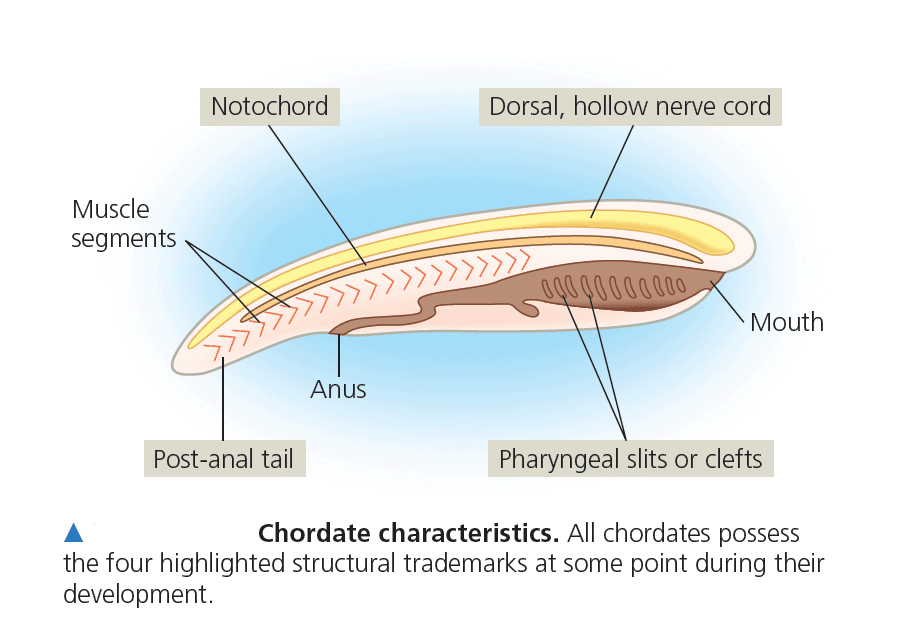Overview: Half a Billion Years of
Backbones
- Early in the Cambrian period, about 530 million years ago, an astonishing variety of invertebrate animals inhabited Earth’s oceans
- One type of animal gave rise to vertebrates, one of the most successful groups of animals
- The animals called vertebrates get their name from vertebrae, the series of bones that make up the backbone
- One lineage of vertebrates colonized land 365 million years ago
- There are about 52,000 species of vertebrates, including the largest organisms ever to live on the Earth
- Vertebrates have great disparity, a wide range of differences within the group
Concept 1: Chordates have a notochord
and a dorsal, hollow nerve cord
- Chordates (phylum Chordata) are bilaterian animals that belong to the clade of animals known as Deuterostomia
- Chordates comprise all vertebrates and two groups of invertebrates, the urochordates and cephalochordates
 |
| Figure 1. Phylogeny of living chordates |
Derived Characters of Chordates
- All chordates share a set of derived characters
- Some species have some of these traits only during embryonic development
- Four key characters of chordates
- Notochord
- Dorsal, hollow nerve cord
- Pharyngeal slits or clefts
- Muscular, post-anal tail
 |
| Figure 2. Chordate characteristics |
Notochord
- The notochord is a longitudinal, flexible rod between the digestive tube and nerve cord
- It provides skeletal support throughout most of the length of a chordate
- In most vertebrates, a more complex, jointed skeleton develops, and the adult retains only remnants of the embryonic notochord
Dorsal, Hollow Nerve Cord
- The nerve cord of a chordate embryo develops from a plate of ectoderm that rolls into a tube dorsal to the notochord
- The nerve cord develops into the central nervous system: the brain and the spinal cord
Pharyngeal Slits or Clefts
- In most chordates, grooves in the pharynx called pharyngeal clefts develop into slits that open to the outside of the body
- Functions of pharyngeal slits
- Suspension-feeding structures in many invertebrate chordates
- Gas exchange in vertebrates (except vertebrates with limbs, the tetrapods)
- Develop into parts of the ear, head, and neck in tetrapods
Muscular, Post-Anal Tail
- Chordates have a tail posterior to the anus
- In many species, the tail is greatly reduced during embryonic development
- The tail contains skeletal elements and muscles
- It provides propelling force in many aquatic species
Lancelets
- Lancelets (Cephalochordata) are named for their bladelike shape
- They are marine suspension feeders that retain characteristics of the chordate body plan as adults
 |
Figure
3 The lancelet Branchiostoma,
a cephalochordate.
Tunicates
- Tunicates (Urochordata) are more closely related to other chordates than are lancelets
- Trunicates most resemble chordates during their larval stage, which may last only a few minutes
- As an adult, a tunicate draws in water through an incurrent siphon, filtering food particles
- When attacked, trunicates, or “sea squirts,” shoot water through their excurrent siphon
 |
Figure
4. A tunicate, a urochordate.
Concept 2 : Craniates are chordates that have a head
- The origin of a head enabled chordates to coordinate more complex movement and feeding behaviors
- Craniates share some characteristics: a skull, brain, eyes, and other sensory organs
Derived Characters of Craniates
- Craniates have two clusters of Hox genes; lancelets and tunicates have only one cluster
- One feature unique to craniates is the neural crest, a collection of cells near the dorsal margins of the closing neural tube in an embryo
- Neural crest cells give rise to a variety of structures, including some of the bones and cartilage of the skull
- In aquatic craniates the pharyngeal clefts evolved into gill slits
- Craniates have a higher metabolism and are more muscular than tunicates and lancelets
- Craniates have a heart with at least two chambers, red blood cells with hemoglobin, and kidneys
Jane B. Reece, Berkeley, California
Lisa A. Urry, Mills College,
Oakland, CA
Michael L. Cain, Bowdoin College,
Brunswick, Maine
Steven A. Wasserman, University of
California, San Diego
Peter V. Minorsky, Mercy College,
Dobbs Ferry, New York
Robert B. Jackson, Duke University,
Durham, North Carolina


ไม่มีความคิดเห็น:
แสดงความคิดเห็น